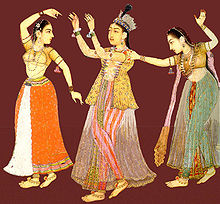Choli

The choli ( Hindi : चोली coli) is the traditional short-sleeved and midriff blouse for Sari , the winding garment of women in the Indian subcontinent . The choli is a blouse that is cut very closely to the body. She leaves the stomach free. Nowadays there are many different shapes - sometimes longer, sometimes shorter, with a round or pointed neckline. Revealing tank tops and bras are very modern and only worn by the upper class on festive occasions.
material
The choli is often made of the same fabric and color as the petticoat worn under the sari. While saris are made of finely woven thin fabric, the fabrics for choli and underskirt are more like linen.
The choli is usually closed with hooks, rarely with buttons. Sometimes there are cords on the back to regulate the width. It used to be believed that items of clothing that came into contact with a needle and thread were unclean.
history
In classical times in the Indo-Asiatic region the upper body of men and women - with a few exceptions at court - was mostly uncovered. Probably it was the Muslims and the Europeans (especially the British ) who found this improper for women and thus propagated the wearing of cholis.
Others
Women in rural areas wear saris when working in the fields - but often without choli, in Gujarats and Rajasthans sometimes combined with a gypsy skirt (called lehanga or lehenga). Their cholis are less tight-fitting than in other areas and are heavily decorated with jewelry, embroidery and sequins .
